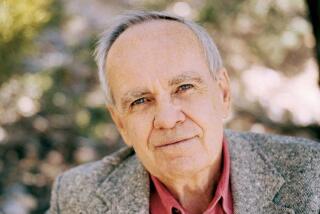‘It’s Always Four O’Clock’ and ‘Iron Man’ by W.R. Burnett
Partway through W.R. Burnett’s 1956 noir “It’s Always Four O’Clock,” one of the central characters, a pianist named Royal Mauch, gives a disquisition about jazz.
“It’s the only live art in the world today,” he tells the novel’s narrator, Stan Pawley. “[J]azz was invented in America. It’s the true expression of American civilization.”
The same could be said of noir, which, with its tough guy existentialism, its bleak examination of the underside of the American mythos, is the literary equivalent of the blues. It’s no coincidence that noir grew out of the Great Depression, when the fairy tale of the United States as a place where everyone could get a fair shake was finally, and definitively, revealed to be a lie.
Burnett knew that story from the inside; born in 1899, he grew up in Ohio and moved to Chicago during the era of Al Capone. His first novel, “Little Caesar,” came out in 1929, the same year as Dashiell Hammett’s seminal “Red Harvest” -- but although Burnett ended up in Hollywood, Hammett got credit for innovating noir.
Over the next several decades, Burnett published more than 30 novels, including “High Sierra” and “The Asphalt Jungle,” both of which he helped adapt for the screen. (As late as the 1960s, he worked on the scripts for “The Great Escape” and “Ice Station Zebra.”) Still, if this gave him financial comfort, his work is now long forgotten, and even at the height of his career, he never lost a certain working-class attitude.
“Me, I’m one of the peasants!” Stan declares in “It’s Always Four O’Clock,” when a rich friend takes him to dinner at Romanoff’s, and it’s hard not to read that as Burnett’s voice.
In both “It’s Always Four O’Clock” and the 1930 boxing novel “Iron Man” -- which have been reissued together in an omnibus edition after many years out of print -- the author’s sympathies are with the down-and-outers: drivers, waiters, beggars, gym rats, all dismissed by the wealthy, speaking in rough English but wise in the ways of the world.
“It’s Always Four O’Clock” is the better of these two novels, a taut piece of midcentury West Coast noir reminiscent, in some ways, of Charles Willeford’s 1953 tour de force “High Priest of California.” In that book, Willeford used the genre as a container into which he might throw a variety of elements: His used-car salesman antihero ruminates on James Joyce even as he takes advantage of a married woman with sociopathic disregard.
Similarly, “It’s Always Four O’Clock” adapts the condensed structure of noir to riff on jazz and family and the burden of inheritance, the way the things that ail us always seem most deeply rooted in the blood. Stan may be the narrator -- he’s the only first-person narrator in Burnett’s work -- but the book belongs to Royal, the damaged son of an industrialist who comes to Hollywood to follow his idiosyncratic muse.
“This Royal -- he broke everything up into pieces,” Stan notes. “The word ‘fracture’ was invented for him. . . . It sounded as though he was changing keys every other bar -- but he wasn’t. . . . [T]ake my word for it, music was never before fractured to the same extent as it was by Royal, not in my hearing, anyway.”
An amateur songwriter, Burnett writes well about music. Yet the key to “It’s Always Four O’Clock” is its embrace of uncertainty, of ambiguity, its sense that we are always on the edge of oblivion and it may take less than we imagine to push us across.
Royal’s fractured piano playing is the expression of a soul infinitely more fractured; it’s music as a cry for help. In evoking that, Burnett opens his novel to the bigger questions -- of identity and meaning, and what we can and cannot stand.
What makes this work is that Burnett is, at heart, a moralist, and his books are popular passion plays.
“Iron Man,” too, is such a story, the saga of a boxer, Coke Mason, who gets caught up with users after winning the middleweight championship. It’s a more generic setup than that of “It’s Always Four O’Clock,” and “Iron Man” is a more generic novel, although effective in a jagged way.
Coke is a good man, just not particularly insightful, and his tendency to trust people is what brings about his fall. For Burnett, this leads to stock situations: the unfaithful wife, the high-hat hangers-on, the pressure for Coke to leave his real friends in favor of an entourage that only values him for his money and cachet.
“He wished it was all over,” Burnett writes at the novel’s end, “then he could go down and lie in the dark. That’s what he wanted to do, lie in the dark.” By the time Coke comes to this revelation, however, it’s already too late.
There’s a degree of predictability here, and compared with “It’s Always Four O’Clock,” “Iron Man” comes off as flatter, more tentative, less willing to play with the parameters of the form. But in its defense, it is the work of a young writer in a developing genre: “Iron Man” was Burnett’s second novel, and its publication predates the work of nearly all of noir’s classic practitioners, other than Hammett and the woefully overlooked Paul Cain.
Considered through such a filter, “Iron Man” becomes a prototypical piece of 1930s noir -- a big story about good and evil, with the stakes articulated in vivid strokes of black and white. In contrast, “It’s Always Four O’Clock” is edgier, more a novel of the fringes, and thus representative of its own period, when beneath a veneer of frantic normalcy, society was fragmenting in the shadow of the atom bomb.
It would be nice to think this was deliberate, that these books have been packaged together to highlight Burnett as a master of two different generations of noir. Yet whatever the intention, their juxtaposition suggests a context in which we may trace both the evolution of a genre and of a career.
More to Read
The biggest entertainment stories
Get our big stories about Hollywood, film, television, music, arts, culture and more right in your inbox as soon as they publish.
You may occasionally receive promotional content from the Los Angeles Times.











